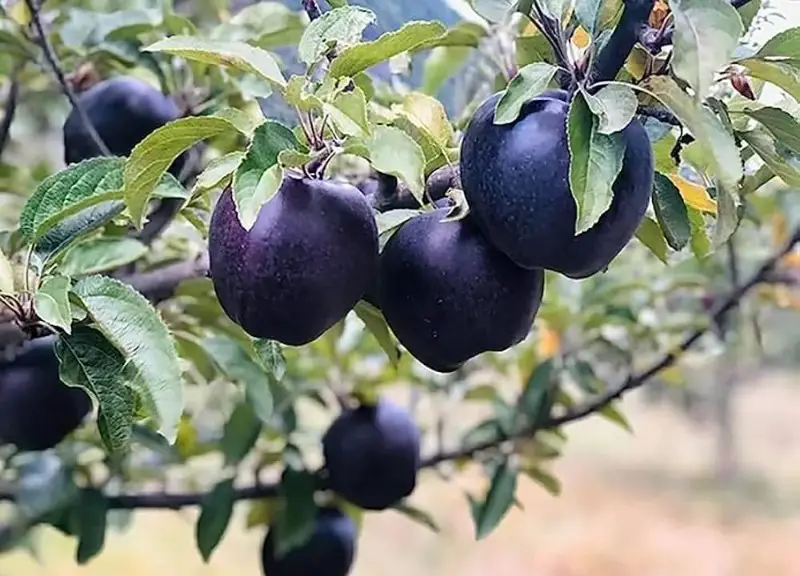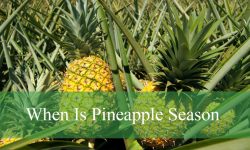Black Diamond apple (Malus domestica) is one of the rarest and most visually stunning apple varieties in the world. Their deep purple to almost black skin, combined with a crisp and sweet interior, makes them highly desirable.
These apples originate from the high-altitude regions of Tibet, where the unique climate contributes to their distinctive coloration and flavor. However, growing and maintaining Black Diamond apple trees requires specific care and attention.
This guide will provide a comprehensive approach to cultivating these extraordinary apples successfully.
Understanding Black Diamond Apple Tree

Origin and Characteristics
Black Diamond apples belong to the Hua Niu apple family, which is widely grown in China. They develop their characteristic dark hue due to intense ultraviolet (UV) exposure at high altitudes. These apples are known for their:
- Deep purple to black skin
- Crisp and juicy texture
- Sweet flavor with slight tart undertones
- High nutritional value, including vitamins and antioxidants
Growing Conditions
To successfully grow Black Diamond apples, it is essential to replicate their natural environment as closely as possible.
- Climate: These apples thrive in cool, high-altitude climates with plenty of sunlight.
- Soil: Well-draining, loamy soil with a slightly acidic to neutral pH (6.0–7.0) is ideal.
- Watering: Moderate watering, ensuring soil remains moist but not waterlogged.
- Sunlight: Full sun exposure is necessary for optimal fruit development.
- Growing Zone: Best suited for USDA hardiness zones 4–8.
- Growth Rate: Slow to moderate, taking 3–5 years to produce fruit when grafted.
Planting Black Diamond Apple Trees
Choosing the Right Location
Selecting an ideal location is essential for the healthy growth and fruit production of Black Diamond apple trees. These trees thrive in full sunlight, so choose a site that receives at least 6–8 hours of direct sunlight daily. Adequate sunlight ensures proper photosynthesis, leading to strong growth and a bountiful harvest.
Additionally, consider wind protection. Strong winds can damage young saplings, break branches, or cause root instability. If your area experiences frequent strong winds, consider planting near a natural windbreak, such as a fence, hedge, or taller trees, while ensuring they do not cast excessive shade.
Soil Preparation
Proper soil preparation is crucial for establishing healthy Black Diamond apple trees.
-
Test the Soil: Conduct a soil pH test before planting. Black Diamond apple trees grow best in slightly acidic to neutral soil (pH 6.0–7.0). If your soil is too acidic, you can amend it with lime to raise the pH. Conversely, if it’s too alkaline, adding sulfur can help lower it.
-
Improve Drainage: Well-draining soil is essential to prevent root rot. If your soil retains too much moisture, consider mixing in sand or organic matter such as peat moss, perlite, or compost. For areas with heavy clay soil, raising the planting area or using raised beds can help improve drainage.
-
Fertilization: Before planting, enrich the soil with organic matter like well-rotted compost, aged manure, or an all-purpose organic fertilizer. This helps provide essential nutrients and supports healthy root development. Avoid using fresh manure, as it can burn the young roots.
Planting Steps
-
Dig the Planting Hole:
- The hole should be twice the width of the tree’s root ball to allow the roots to spread easily.
- Dig deep enough to ensure the roots are fully covered without being cramped.
-
Position the Sapling:
- Place the sapling in the hole, ensuring that the graft union (if present) remains above the soil level to prevent disease.
- Spread the roots gently to encourage outward growth.
-
Backfill and Compact:
- Refill the hole with the excavated soil, gently tamping it down in layers to remove air pockets.
- Avoid compacting the soil too much, as this can restrict root growth.
-
Water Thoroughly:
- After planting, give the tree a deep watering to help settle the soil and promote root establishment.
- Continue to water regularly, especially during the first year, to ensure consistent moisture.
-
Mulch for Moisture and Weed Control:
- Apply a 2–3 inch layer of mulch (such as wood chips, bark, or straw) around the base of the tree.
- Keep the mulch a few inches away from the trunk to prevent rot and discourage pests.
Care and Maintenance
Watering Requirements
Proper watering is essential for the health and productivity of Black Diamond apple trees.
- For Young Trees (First Year): Water twice a week, ensuring the soil remains moist but not waterlogged. Newly planted saplings have underdeveloped root systems and require consistent moisture to establish themselves.
- For Mature Trees: Once the tree is established, reduce watering to once a week, adjusting based on rainfall and soil moisture levels. During hot, dry periods, additional watering may be necessary.
- Avoid Overwatering: Too much water can lead to root rot and other fungal diseases. The soil should be moist but well-drained. To check if the tree needs water, insert a finger or a moisture meter into the soil about 2–3 inches deep—if it feels dry, it’s time to water.
Fertilization Schedule
A well-planned fertilization schedule enhances growth, fruit production, and overall tree health.
- Early Spring (Before Bud Break): Apply a balanced fertilizer (10-10-10) to promote root and shoot growth. This provides equal amounts of nitrogen (N), phosphorus (P), and potassium (K), which are essential for strong early-season development.
- After Flowering (During Fruit Set): Use a potassium-rich fertilizer (such as 5-10-15) to support fruit formation and improve fruit quality. Potassium enhances sugar production, making the apples sweeter and more flavorful.
- Fall (Before Dormancy): Apply organic compost or mulch to enrich the soil and prepare the tree for winter dormancy. This helps maintain soil fertility and protects the roots from temperature fluctuations. Avoid high-nitrogen fertilizers in the fall, as they may encourage unwanted late-season growth.
Pruning Techniques
Regular pruning ensures that Black Diamond apple trees remain healthy, well-shaped, and productive.
-
Winter Pruning (Dormant Season):
- Remove dead, diseased, or damaged branches to prevent the spread of disease.
- Cut back weak or crossing branches to encourage stronger structure and airflow.
- For young trees, establish a strong central leader (for an upright shape) or an open-center shape (for better sunlight exposure).
-
Summer Pruning (During Active Growth):
- Thin out overcrowded branches to improve air circulation and sunlight penetration, reducing the risk of fungal diseases.
- Remove excessive water sprouts (vigorous vertical shoots) that divert energy from fruit production.
-
Shape Maintenance:
- Black Diamond apple trees can be trained into different shapes for optimal fruit production. The two most common pruning styles are:
- Central Leader System: A single dominant trunk with horizontal branches, ideal for strong growth and support.
- Open-Center System: A vase-like shape with multiple main branches, allowing better light distribution and fruit development.
- Black Diamond apple trees can be trained into different shapes for optimal fruit production. The two most common pruning styles are:
Pest and Disease Management
Common Pests
Black Diamond apple trees are vulnerable to several pests that can hinder their growth and reduce fruit quality. Regular monitoring and preventive measures are key to maintaining a healthy tree.
Aphids are small insects that feed on sap, causing leaves to curl and stunt growth. They usually cluster on young shoots and the undersides of leaves. To control aphids, spraying neem oil or insecticidal soap is effective. Encouraging natural predators such as ladybugs and lacewings can also help keep their population in check.
Codling moths lay eggs on developing apples, and their larvae burrow into the fruit, creating tunnels and making them inedible. To reduce infestations, pheromone traps can be used to disrupt their mating cycle. Wrapping tree trunks with corrugated cardboard bands can also trap larvae before they pupate. Applying Bacillus thuringiensis (Bt), a natural bacterial pesticide, can further control young larvae.
Apple maggots are small flies that lay eggs on apples, and their larvae tunnel inside the fruit, causing internal browning. Sticky red ball traps coated with tanglefoot glue are effective in capturing adult flies. Regularly removing fallen fruit prevents further infestations. Kaolin clay spray can also act as a deterrent for egg-laying females.
Common Diseases
Like most apple trees, Black Diamond apples are susceptible to fungal and bacterial infections, which can affect their overall health and fruit yield.
Apple scab is a fungal disease that appears as dark, rough, olive-green to black spots on leaves and fruit. Infected leaves may drop prematurely, and affected apples often become deformed. To manage apple scab, spraying copper-based fungicides in early spring can help prevent the spread. Proper pruning improves air circulation, reducing moisture buildup that fosters fungal growth.
Powdery mildew presents as white, powdery patches on leaves, buds, and fruit, leading to distorted growth. This disease thrives in warm, dry conditions but spreads with humidity. Pruning infected shoots and applying sulfur-based sprays or potassium bicarbonate treatments are effective control methods. Watering at the base rather than overhead helps keep foliage dry, reducing the risk of infection.
Fire blight is a bacterial disease that causes shoots, flowers, and branches to blacken and die, giving the tree a scorched appearance. To prevent its spread, infected branches should be pruned at least 12 inches below the affected area, and pruning tools must be disinfected between cuts. Avoiding excessive nitrogen fertilization is crucial, as rapid new growth is more vulnerable to infection. Preventive sprays, such as streptomycin or copper-based solutions, can help protect trees during the blooming season.
General Prevention Tips
Keeping the area around the tree clean by removing fallen leaves and fruit helps prevent the recurrence of diseases and pest infestations. Regular inspections allow for early detection and intervention. Encouraging beneficial insects, such as ladybugs and parasitic wasps, provides natural pest control. Additionally, maintaining good airflow through proper pruning and spacing between trees reduces the likelihood of fungal infections.
Harvesting and Storage
When to Harvest
Black Diamond apples typically reach full maturity in late autumn, usually between October and November. The best way to determine the right time for harvesting is by observing several key indicators. The most obvious sign is the deep purple to nearly black skin, which signifies full ripeness. Additionally, ripe apples should feel firm and crisp when gently pressed. A sweet, slightly floral aroma is another strong indicator that the fruit is ready to be picked.
To confirm ripeness, conduct a simple taste test—fully matured Black Diamond apples have a rich, sweet flavor with a hint of tartness. Another method is to check the seeds inside a test apple; if they are dark brown, the fruit has ripened completely.
Proper Harvesting Techniques
Harvesting Black Diamond apples requires care to avoid damaging the tree and fruit. The best method is to use pruning shears to cut the stem, especially when harvesting in large quantities. If harvesting by hand, gently twist and lift the apple upwards rather than pulling it straight down, as excessive force can damage the fruit spurs, reducing next season’s yield.
Handle apples carefully to prevent bruising, as damaged fruit has a much shorter shelf life. It’s advisable to place them gently into a basket or crate rather than dropping them into a container. Avoid stacking too many apples on top of one another, as the pressure can cause bruising and lead to faster spoilage.
Storage Tips
Proper storage is crucial for maintaining the freshness and quality of Black Diamond apples. The ideal storage method depends on how long you plan to keep them.
For short-term storage, apples can be kept at room temperature for about one to two weeks. However, they should be placed in a cool, dry area away from direct sunlight and heat sources.
For medium-term storage, refrigeration can significantly extend shelf life. Storing apples in the crisper drawer of a refrigerator at around 35–40°F (1–4°C) helps preserve their crisp texture and fresh taste for up to three months. Wrapping apples individually in paper towels or placing them in ventilated plastic bags can also prevent moisture buildup and slow the ripening process.
For long-term preservation, professional cold storage at 32°F (0°C) is the best option. Apples stored in controlled humidity and temperature conditions can last several months without losing their quality. If cold storage is not available, an unheated basement or cellar with good air circulation can serve as an alternative.
Regardless of the storage method, apples should be checked periodically for signs of spoilage. One rotten apple can accelerate decay in others, so any soft, bruised, or moldy fruit should be removed immediately. With proper harvesting and storage techniques, Black Diamond apples can retain their exquisite flavor and texture well beyond the harvest season.
Propagation Methods
Growing Black Diamond apple trees requires careful selection of propagation methods to ensure healthy growth and fruit production. While growing from seeds is an option, it does not guarantee that the offspring will retain the exact characteristics of the parent tree. Grafting is the preferred method for preserving the desirable traits of the Black Diamond variety.
Growing from Seeds
Although it is possible to grow Black Diamond apple trees from seeds, this method often results in genetic variation, meaning the new tree may not produce apples identical to the parent fruit. However, growing from seeds can be an enjoyable process for hobbyists or those interested in breeding new apple varieties.
To begin, extract seeds from a fully ripened Black Diamond apple. Rinse them thoroughly to remove any fruit residue, as leftover sugars can encourage mold growth. After cleaning, the seeds must undergo stratification, a cold treatment that mimics winter conditions and encourages germination.
Stratification involves placing the seeds in a moist paper towel inside a sealed plastic bag, which is then stored in the refrigerator at approximately 32–40°F (0–4°C) for 6–8 weeks. It is important to check periodically to ensure the seeds remain moist but not overly wet, as excess moisture can cause rot.
Once stratification is complete, plant the seeds in small pots filled with well-draining soil. Position them in a warm, sunny location or under a grow light to encourage sprouting. Keep the soil consistently moist but not waterlogged. Seedlings typically emerge within a few weeks to a couple of months.
When the young trees reach about 12 inches (30 cm) in height, they are ready for transplantation into the ground. Choose a planting site with full sunlight and well-draining soil to support healthy root development. Keep in mind that seed-grown trees may take several years to mature and bear fruit, and the apples they produce may differ from the original Black Diamond variety.
Grafting Method
For those looking to cultivate true Black Diamond apple trees with identical fruit characteristics, grafting is the most reliable propagation method. Grafting involves attaching a piece of an existing Black Diamond apple tree (the scion) to a different tree’s root system (the rootstock).
Start by selecting a healthy rootstock that is compatible with apple trees. The choice of rootstock will influence the tree’s size, disease resistance, and adaptability to soil conditions. Common apple rootstocks include M26 (semi-dwarf), MM106 (semi-vigorous), and MM111 (vigorous), depending on the desired tree size.
Once the rootstock is chosen, take a scion cutting from a mature Black Diamond apple tree during its dormant season (late winter to early spring). The scion should be about 6–8 inches (15–20 cm) long, with at least three buds.
There are several grafting techniques, but the whip-and-tongue graft and cleft graft are among the most effective for apple trees. In the whip-and-tongue method, both the rootstock and scion are cut at a matching angle, creating a tight fit for better nutrient transfer. The cleft graft involves splitting the rootstock and inserting the scion into the opening.
After attaching the scion to the rootstock, wrap the graft union with grafting tape or wax to keep it secure and prevent moisture loss. Place the grafted tree in a protected area and monitor it for new growth. Once the graft has successfully fused, it can be transplanted to a permanent location.
With proper care, a grafted Black Diamond apple tree will begin bearing fruit in 3–5 years, significantly earlier than a tree grown from seed. By choosing the right propagation method, growers can successfully cultivate these rare and visually stunning apples while ensuring their desired characteristics are preserved.
Frequently Asked Questions
Are Black Diamond Apples Genetically Modified?
No, Black Diamond apples are a naturally occurring variety. Their dark color results from exposure to high-altitude sunlight.
Can I Grow Black Diamond Apples in Warm Climates?
These apples prefer cooler temperatures. However, they can be grown in warmer regions with sufficient care, shade, and soil adjustments.
How Long Does It Take for a Black Diamond Apple Tree to Bear Fruit?
Grafted trees typically produce fruit within 3–5 years, while trees grown from seed may take 6–10 years.
Why Are Black Diamond Apples Expensive?
They are rare, slow-growing, and primarily cultivated in Tibet, making them a luxury fruit with limited availability.
Conclusion
Growing Black Diamond apples requires dedication, but the reward is a stunning and delicious fruit. By providing the right climate, soil conditions, and care, you can cultivate these rare apples successfully. Whether you are an apple enthusiast or a commercial grower, this guide ensures you have all the necessary information for thriving Black Diamond apple trees.






